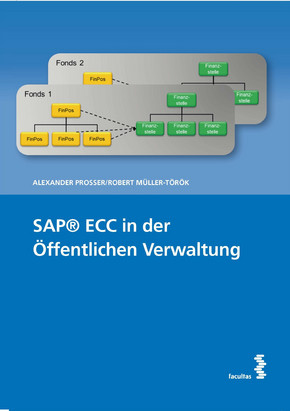Public Administration with SAP ECC

Download Material (English - German)
Online Training Material (English only)
Content
Lecture I:
This lecture implements
Process and Data Management with widely used industry tools, AdonisTM for process modelling and analysis and Visual ParadigmTM for data modelling.
Funds Management: Budgeting master data and their link to Accounting and Logistics.
Budgeting incl. supplements and returns, budgeting in several funds; funds release.
Budget execution: Commitment and invoice processing, revenues.
Auditing and accountability.
Lecture II:
The lecture implements a section if the service yard of a municipality, street cleaning services:
Cost accounting master data is introduced, cost centres, cost elements and activities and linked to items in financial accounting.
A primary cost and acitivity plan is established: There are direct cost centres, overhead cost centres surcharge type, and overhead cost centres allocation type. The latter are allocated to the remaining cost centes and the activity prices in direct cost centres calculated.
Materials management in the service yard is initiated with various materials management methods being applied. A net demand calculation gives purchase requisitions.
Procurement master and control data is initiated and the procurement process is performed including order release procedures.
The service rendered, street cleaning, is created, the material consumption and service routings are created. This service is also the cost objective.
A street cleaning order is created, scheduled and the material requirements are calculated. The order is calculated which closes the link between accounting and logistics. The order is executed and the cost objective updated.
Learning Outcomes
Future leaders in public administration learn what ERP systems are, how they are implemented in the public sector and how they may be leveraged to make public administration more efficient and transparent. Every student implements the business case in a separate virtual municipality in SAP ECC and gains practical, first-hand experience with the system.
Acknowledgement

Development of this lecture series was supported by the State Ministry of Baden-Württemberg.
See partners in ERP4PA.
Links zur ERP Fallstudie
These links are only available in German and refer to the German book version.
1. KOSTENRECHNUNG
Zuordnung der Kapitel:
| Lektion | Inhalt des Kapitels | Buch |
| CO.01 | Einführung in SAP | 8.1 |
| CO.02 | Einführung in das Beispiel | 8.1 |
| CO.03 | Kostenartenplan | 8.2 |
| CO.03ERM | Zugriffsrechte Datenmodell am Beispiel Kostenrechnung | |
| CO.04 | Verknüpfung Sachkonto - Kostenart - Finanzposition | 8.2 |
| CO.05 | Leistungsarten | 8.2.2 |
| CO.06 | Kostenstellenüberblick | 8.2.3 |
| CO.07 | Erfassen Gebäudekostenstelle (Overhead) | 8.2.3 |
| CO.07UE | Übung: Erfassen Kostenstellen im Overheadbereich | |
| CO.08 | Erfassen Straßenkehrerkostenstelle (Leistungsbereich) | |
| CO.09UE | Übung: Erfassen Kostenstellen im Leistungsbereich | |
| CO.10 | Anzeigen Kostenstellengruppe | 8.2.3 |
| CO.10UE | Ändern einer Kostenstelle | |
| CO.11 | Leistungsartenplanung | 8.3.1 |
| CO.12 | Planung direkte Kostenstelle | 8.3.2 |
| CO.13UE | Übung: Planung direkte Kostenstelle | |
| CO.14 | Planung Kostenstelle im Overhead | 8.3.3 |
| CO.15UE | Übung: Planung Kostenstelle im Overhead | |
| CO.16 | Kostenstellenplanbericht ohne Umlagen | 8.3.4 |
| CO.17 | Anlegen Statistische Kennzahl m2 und Beplanen | 8.4.1-2 |
| CO.18 | Masterposting Key Umlage Gebäude mit Durchführung | 8.4.3-4 |
| CO.19 | Kostenstellenbericht nach Umlage Gebäude | 8.4.5 |
| CO.20UE | Übung: Anlage und Planung von statistischer KennzahlLeistungsstunden für Umlage Wartung (Umlagekostenstelle) | |
| CO.21UE | Übung: Master Buchungssatz Wartung | |
| CO.22UE | Prüfen Resultat der beiden Umlagen | 8.4.5 |
| CO.23 | Tarifermittlung | 8.5 |
2. MATERIALWIRTSCHAFT/BESCHAFFUNG
Zuordnung der Kapitel:
| Lektion | Inhalt des Kapitels | Buch |
| MM.01 | Anlegen Material | 9.1 |
| MM.01a | Exkurs: verbrauchsgesteuerte Disposition | |
| MM.02 | Übung: Anlegen Material | |
| MM.03 | Suchfunktion für Materialstämme und Änderungsfunktion | 9.1 |
| MM.03a | Übung Anlegen Material mit Template | |
| MM.04 | Anlegen Tankmaterial | 9.1.13 |
| MM.05 | Anlegen plangesteuert disploniertes Material | 9.1.12 |
| MM.06 | Anlegen Pipelinematerial (Wasser) | 9.1.13 |
| MM.07 | MRP Lauf, Dispoliste, Banf-Liste | 9.2.1 |
| MM.08 | Direktbedarfe | 9.2.2 |
| MM.09 | Anlage Leferantenstammdaten (Municipii Supplementum) | 9.3.2 |
| MM.10 | Übung: Anlegen Lieferant | |
| MM.11 | Übung: Anlegen Lieferant, Sonderkonditionen | |
| MM.11a | Anzeigen Lieferanten | |
| MM.12 | Infosatz anlegen | 9.3.3 |
| MM.13 | Übung: Anlegen Infosatz | |
| MM.14 | Übung: Anlegen Infosatz mit Konditionen | |
| MM.15 | Anlegen Infosätze, Rest | |
| MM.16 | Anlegen Infosatz Pipelinematerial | 9.3.3 |
| MM.17 | Liste der Infosätze | 9.3.4 |
| MM.18 | Records Management am Beispiel Einkauf | 9.3.5 |
| MM.19 | Freigabeworkflow Einkauf | 9.4.2 |
| MM.19a | Customizing Freigabeworkflow | 9.4.2 |
| MM.20 | Bezugsquellenzuordnung, Bestellung Materialien | 9.4.1, 9.4.3 |
| MM.21 | Übung: Bezugsquellenzuordnung, Bestellung Materialien | 9.4.3 |
| MM.22 | Übung: Bestellung mit Preisspiegel | 9.4.3 |
| MM.23 | Liste Bestellungen | 9.4.3 |
| MM.24 | Wareneingang zur Bestellung | 9.4.4 |
| MM.25 | Übung: Wareneingang zur Bestellung | |
| MM.26 | Übung: Wareneingang mit QS- und Sperrbestand | |
| MM.27 | Umbuchung QS- und Sperrbestand | |
| MM.28 | Lagerbestandsübersicht | 9.4.5 |
3. SERVICEMANAGEMENT
Link zu den Lektionen
| Lektion | Inhalt des Kapitels | Buch |
| SM.01 | Anlegen Servicematerial | 10.2 |
| SM.01a | Erfassen Dienstleistung | 10.2 |
| SM.02 | Stückliste für Dienstleistung | 10.2.2 |
| SM.03 | Anlegen Reinigungs-Lkw als Maschinenarbeitsplatz | 10.1 |
| SM.04 | Anlegen Kapazitäten zum Arbeitsplatz | 10.1.2 |
| SM.05 | Übung: Anlegen Arbeitsplatz | |
| SM.06 | Anlegen Arbeitsplan | 10.2.4 |
| SM.06a | Übung: Anlegen Arbeitsplan | |
| SM.07 | Auftrag anlegen, prüfen und freigeben | 11.1-3, 11.5 |
| SM.08 | Übung: Auftrag anlegen | |
| SM.09 | Customizing Terminierung, Verfügbarkeitsprüfung | 11.4 |
| SM.10 | Customizing Kalkulation | 11.4 |
| SM.11 | Warenentnahme vor Bearbeitung | 12.1 |
| SM.11a | Übung: Prüfung Auftrag | |
| SM.12 | Rückmeldung | 12.2 |
| SM.12a | Übung: Prüfung Auftrag nach Rückmeldung | |
| SM.13 | Warenentnahme nach Bearbeitung | 12.3 |
| SM.14 | Dienstleistungsempfang | 12.5 |
| SM.15 | Bewertung und Lagerbestand | 12.5 |
| SM.15a | Customizing Wareneingang | |
| SM.16 | Overheads Istkosten | 12.4 |
| SM.17 | Abrechnungsvorschrift | 12.5 |
| SM.18 | Übung: Abrechnung | 12.5 |
| SM.19 | Resultat Zubuchund und Abrechnung in der Dienstleistung | 12.5 |
Some links to the methods used
Among them true classics in information science
P.P. Chen, Entity-Relationship Modeling
